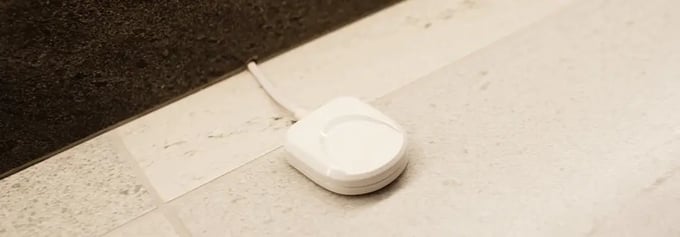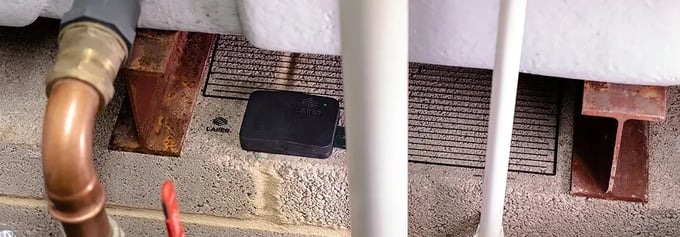The cost of water damage is immense - flooding, broken pipes, and minor hidden leaks are the leading cause of commercial property insurance claims. After analyzing nearly half a million claims made in over 200 countries over a 5-year period, Allianz Global Corporate & Security found that water damage was responsible for the the third-highest number of insurance claims.
It’s a serious pain point not just for commercial building owners, but also for the insurers that have to underwrite them. In the future, costs will always rise. In response to this insurers are recommending the use of water leak detection technology.
There are a range of water leak solutions, including sensors, alarms, monitoring platforms, and automatic shut-off valves. The main idea is to use these tools to detect water leaks as early as possible to minimize damage and downtime.
Whether you're trying to protect a multifamily residential building, retail store, or manufacturing facility, it's important to understand how these components work before investing in them. For the purposes of this article, we're focusing on smart water leak sensors, as they're now becoming the standard for remote water leak detection.
What kinds of water leak sensors are available?
There are four main types of sensor-based water leak detection available to protect commercial and industrial premises and equipment from damage and downtime due to water leaks:
- Flood sensors, also known as pucks.
- Rope or cable sensors.
- Printed sensors.
- In-line sensors, or flow meters.
1. Flood sensors, or pucks
Flood sensors, also known as pucks, or spot leak sensors, are probably the best-known type of water leak sensor. They're usually small, palm-sized pucks or blocks, with one or more probes attached. Pucks are often installed next to hot water tanks, or near appliances like dishwashers or washing machines. Examples of pucks include Flo, Phyn, and Monnit.
Pucks have the benefits of being easy to deploy and easy to power with standard-size household batteries. And when they touch water, many of them have a loud alarm to alert you to a possible leak. In more sophisticated systems, visual or auditory alarms are replaced with wireless communication methods such as Wi-Fi, Bluetooth or LoRaWAN®, to alert facilities management teams directly.
The biggest downside to puck sensors is that they're small, and can only detect water when it reaches their probes. If you don't place them directly under a leak source, it could have already caused significant water damage before reaching the sensing probe. And if water leaks into absorbent material like insulation or drywall, pucks won't be able to detect these leaks until the material can't absorb any more water.
When it comes to tight or angles spaces, flood sensors aren't ideal - they're typically made with hard, inflexible casings; and designed to only work on flat surfaces.

2. Rope or cable sensors
Whereas pucks only tend to detect significant escape of water, rope or cable sensors are designed to detect any moisture as early as possible. You may be familiar with products from companies like Alliot, AKCP, and ALTA.
Water sensing cables come in a variety of lengths, but all work on the same premise: a leak is detected when a cable becomes wet. Because these sensors can be long, they're often used to cover larger expanses, whether the edges of a room, or the full area.
Rope sensors do have disadvantages, however. They're susceptible to false positives (detecting leaks that aren't actual leaks) from dust, meaning they're less suitable for dusty areas. Once a leak has been detected and repaired, rope sensors also require a long time to fully dry, which means the affected areas has no leak detection active during this period. And they're pricey, coming in at around five times the cost of a typical flood sensor.
3. Printed sensors
Like rope sensors, printed sensors have been designed to detect the presence of moisture as soon as possible. But unlike rope sensors, they're based on a flat, thin polymer substrate that's affordable to scale across large areas.
Printed sensors also have the advantage of completely covering large areas whilst being flush to the surface, unlike rope sensors or pucks. Furthermore, they're typically wipe-dry, meaning that leak detection can continue uninterrupted.
Printed water leak detection sensors are a newer addition to the market, and there are fewer options on the market. Severn WLD™ stands out for its ability to offer the scale and precision of water leak detection that commercial and industrial premises require, at a cost that they can bear. Uniquely, Severn WLD's sensor has 12 distinct zones, which enables users to not only detect the presence of water, but also the severity of the leak.
4. In-line sensors or flow meters
In-line or flow meters are important to mention, but very different from the previous 3 types of sensors.
Whereas pucks, ropes, and printed sensors require direct contact with water in order to detect leaks, flow meters don't. Instead, they monitor flow rate and water pressure inside water inlet pipes to deduce if there's a leak. You may be familiar with flow meter products from companies like Grohe, ABB, and Flume.
Flow meters are installed within a water network, and work in a similar way to water meters. Invasive flow meters (which require pipe cutting) measure the rate at which water travels through a pipeline via a rotating fan. The higher the flow rate of water, the faster the blades spin. If water is used at a high rate for a prolonged period, it may imply the presence of a leak.
Non-invasive flow meters are clipped onto pipes. Most use ultrasonic technology to track the water flow through pipes. If a water leak is present, small bubbles emit particular sound waves that can be flagged as a leak.
More advanced flow sensor technology has started to use machine learning capabilities to record usage patterns, and detect abnormal usage.
Flow meter sensors have the advantage of being installed within your plumbing network so leaks anywhere in the network can be detected. Some include automatic shutoff functionality if critical thresholds have been met.
One major disadvantage is that flow meters can't tell exactly where a water leak is located. Furthermore, despite being able to detect very small deviations, they're also notorious for false positives: the impact of an expansion tank in a hot water system can be detected as a leak, which can flag up a false alarm; on the other hand, small leaks may not be detected at all.

The right kind of water leak sensor can make facilities management work much easier
Each sensor type has its pros and cons, but you must also understand what your building type requires before deciding on the best sensor. For low budgets, flood sensors may be the best suited if accuracy or reliability is unimportant. For more critical scenarios with tight spaces, printed sensors are much more appropriate.
Want a more in-depth comparison of the latest water leak sensors? Download our technical comparison eBook to read more.
Prefer a personal approach? Our team would love to hear from you - book a call for a conversation about water leak detection requirements on your buildings.
